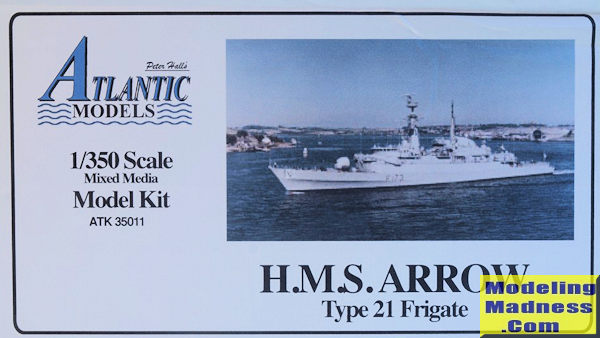
Atlantic Models 1/350 HMS Arrow
| KIT #: | 35011 |
| PRICE: | 123.95 GBP |
| DECALS: | Several options |
| REVIEWER: | Frank Spahr |
| NOTES: | Resin multi-media kit |

| HISTORY |
The Type 21 Frigate was the Royal Navy’s first privately designed ship taken into service for a long time. The RN had a requirement for a general purpose vessel to replace the Leopard and Salisbury class Frigates that were not very well suited to escort duties due to their diesel power plants. Vosper Thornycroft came up with a modern designed frigate that they claimed was comparatively cheaper than the Leander class frigates already in service. The new ship was all gas turbine powered and was not restricted by having to allow time for boilers to bring up steam for propulsion.
The Admiralty ordered eight ships of the new class beginning with the name ship HMS Amazon with all of the remainder of the classes names beginning with A and these were all accepted into service between July 1974 and April 1978.
The type was well liked by all those that served in them, but because of their small size and lack of long range radar, there was no prospect of being able to modernise them as they were already close to their top weight limits.
All of the class served during the Falklands campaign of 1982 with Amazon being the only one to arrive late in the second group of ships after the Argentine surrender. Two of the class were lost to enemy fire. Ardent was strafed and bombed repeatedly by flights of aircraft on the 23rd May and sunk. Antelope received bomb hits which failed to explode, but one was set off by the disposal team attempting to defuse it. The resulting fire set off the ships magazines which broke her back and sinking her.
HMS Arrow was built by Yarrow Shipbuilders Ltd, Glasgow and launched on 5th February 1974 by Lady Raper, wife of Vice Admiral Sir George Raper, Arrrow was the fifth Type 21 Frigate to be built and the first to carry Exocet missiles. She was commissioned on 29th July 1976 in Sunderland, the town to which she was affiliated.
HMS Arrow served along with all her sister ships that made up the 4th Frigate squadron, during the Falklands campaign in 1982, and was in the first wave of ships deployed. She claimed the distinction of being the first ship to fire on the Argentine shore positions as well as the first ship to be hit by enemy fire after being strafed by a fighter jet.
She went alongside HMS Sheffield after the missile attack which disabled her, and helped to take off the survivors. She operated in and around Falkland sound with HMS Alacrity, keeping the seaway open and providing gunfire support to the troops ashore.
After Arrow returned from home she went into refit until September 83 after which she headed back to the Falklands as guardship. She also spent time in the West Indies as guardship and carrying out anti priracy patrols.
HMS Arrow served in the fleet until 1994 after which she was decommissioned and sold to the Pakistan Navy and re named PNS Khaibar.
She remains in service to this day in the Pakistan Navy where she serves alongside the other five remaining Type 21 Frigates that were purchased from the United Kingdom.
| THE KIT |
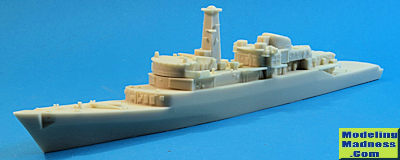 Atlantic Models widens their range of Cold War era resin ship kits. This is the
first resin kit and the first in 1:350 scale of this subject. So far, your only
options for building a type 21 from a kit were the old 1:600 Airfix kit or the
newer Dragon offering in nominally 1:700, which it is not.
Atlantic Models widens their range of Cold War era resin ship kits. This is the
first resin kit and the first in 1:350 scale of this subject. So far, your only
options for building a type 21 from a kit were the old 1:600 Airfix kit or the
newer Dragon offering in nominally 1:700, which it is not.
This kit is a typical Peter Hall offering. Peter has for a long time developed PE sets for WEM, but is also an accomplished pattern maker. With the end of the original WEM, he focused on his own Atlantic Models label and now offers his own kits and PE sets. The kit arrived at my home well packed in a cardboard box, the parts secured in plastic bags, shrink wrap and styrofoam packing chips.
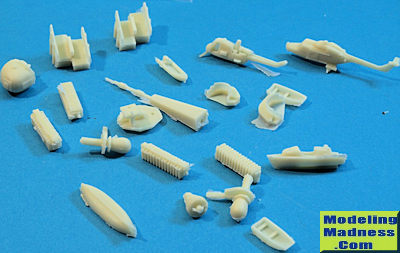 21
different resin parts, amongst them a hull split at the waterline
21
different resin parts, amongst them a hull split at the waterline
17 different parts from white metal
1 photo etch fret with 92 different parts
1 piece of 1 mm brass wire for propellor shafts
1 decal sheet for ship and helos
The resin parts are well made and crisply cast, without any major visible blemishes. There is some little flash, but no pour stubs to be removed. The hull is split at the waterline; the parts fit quite well even without any cleanup. I do not at this stage anticipate major trouble here. Parts of the superstructure are included in the hull, with the bridge, the foremast, the midships superstructure with the funnel, and the hangar being provided as additional components. The hangar part displays some nice internal ribbing which might be visible if displayed open.
The
remaining resin parts comprise (amongst others) the Exocet canisters, their
bases, the deflectors around the chaff dispensers, the main mast in its ea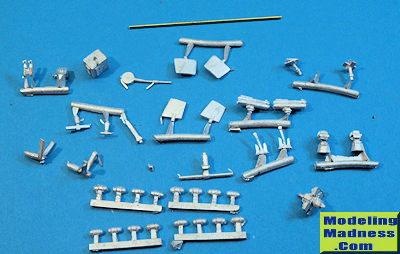 rly
form, the gun turret, the various boats and the two helo types in use aboard the
class, namely the Westland Wasp and Sea Lynx. They are crisply cast and should
need only minimal cleanup.
rly
form, the gun turret, the various boats and the two helo types in use aboard the
class, namely the Westland Wasp and Sea Lynx. They are crisply cast and should
need only minimal cleanup.
The white metal parts are different. Some are quite neat, but some are not, like the A-frames for the propellor shafts or the triple torpedo tubes (available as crisp resin items from L´Arsénal, by the way). I feel that there are better ways of producing such parts these days. I would also have preferred the gun barrel to be provided as a machined brass item. Generally speaking, the parts are usable, though.
As always with Peter Hall, the PE fret is very good. The large number of parts are crisply etched, finely detailed, yet do not look overly iffy or overly hard to remove from the fret. I have so far found no parts I would feel unable to tackle. There are some parts though which I would have preferred in a different medium, namely the Oerlikon barrels, the propellors and the Seacat missiles. All of them I expect to look too flat and two-dimensional in this scale.
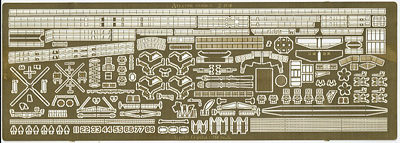 The
railings are tailor-made with fine detail and should enhance the model´s look a
lot. There´s a lot of additional detail here, like nameplates for all vessels of
the class and funnel numbers for peacetime squadron use.
The
railings are tailor-made with fine detail and should enhance the model´s look a
lot. There´s a lot of additional detail here, like nameplates for all vessels of
the class and funnel numbers for peacetime squadron use.
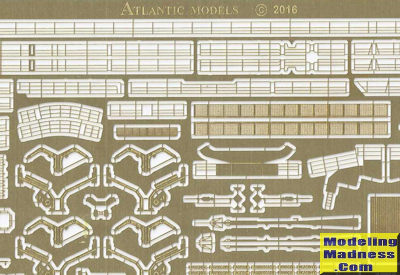 The
decal sheet looks sharply printed and comprehensive. There are hull numbers and
names, draught markings, flight deck markings, the warning circle surrounding
the gun turret, plus markings for the helos - for all vessels of the class.
The
decal sheet looks sharply printed and comprehensive. There are hull numbers and
names, draught markings, flight deck markings, the warning circle surrounding
the gun turret, plus markings for the helos - for all vessels of the class.
The kit instructions are comprehensive, clear and obviously made for modelers from a modeler. The construction sequence is reasonable and realistic, the work needed on the various subassemblies is neatly shown. All items are clearly named and identified. Alternative fits are mentioned. The colour profiles for the ship (HMS Arrow in her post Falklands fit in 1985) and the helos are clear. The flight deck and hull markings for all the units in the class are listed, same as their respective ship´s flights. The colour shades needed are listed and Humbrol equivalents given.
The instructions are downloadable at: http://atlanticmodels.net/onewebmedia/Arrow350.pdf
This kit contains virtually everything needed to build a highly detailed model of any type 21 during their RN service. Aftermarket parts would only make sense for the gun barrels and possibly the torpedo tubes.
You will have to do your own research if you intend to build another vessel or Arrow at an earlier date. The kit comprises all the modifications made to the class, but you will need to find out what is needed for your project.
Even though the class was not modified to a larger extent, the following was done:
Exocet launchers were retrofitted (Ambuscade received hers only 1984/5)
The triple torpedo tubes were not originally installed but retrofitted later
Only after the Falklands, two single 20 mm Oerlikons were retrofitted
The main mast was widely modified to accomodate new electronics
The ship´s boats fit was changed and reduced
After structural failure occured in the South Atlantic in several vessels, longitudinal stiffeners were added at main deck level.
| CONCLUSIONS |
This is a very neat kit of an elegant vessel with a dramatic service history in the South Atlantic - highly recommended.
| REFERENCES |
August 2016
Copyright ModelingMadness.com
If you would like your product reviewed fairly and fairly quickly, please contact the editor or see other details in the Note to Contributors.